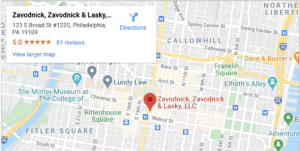
An injured person may be entitled to receive compensation for their injuries and damages after an accident. Under personal injury lawyers, the injured party must prove liability before receiving any money for their claim.
Damages for a personal injury may include:
- The cost of medical treatment and medical expenses
- Future medical bills and loss of income because of permanent impairments or disability
- Lost wages and benefits
- Pain and suffering damages
- Reductions in earning potential
- Loss of enjoyment of life and reduced quality of life
The amount of money you receive for your claim depends on several factors, including the strength of your evidence regarding liability.
Table of Contents
Proving Liability for Personal Injury Cases
Several causes of action could create liability for a personal injury. The legal theory used to determine negligence and liability for an accident depends on the circumstances of the case.
Strict Liability
Strict liability applies in most product liability cases. It also applies in cases involving inherently dangerous activities, dog bites, and wild or exotic animal attacks.
When a party is strictly liable for damages, you do not need to prove intent or negligence. You only need to prove that the defendant’s actions were a direct and proximate cause of your injury and damages. Strict liability can be useful in a personal injury lawsuit where the defendant caused an injury without malice, forethought, or negligent behavior.
General Negligence
Negligence claims require that you prove specific legal elements to win the case. You must prove that the defendant in a lawsuit:
- Had a relationship with you that created a duty of care, such as a doctor-client relationship in a medical malpractice case
- Breach of the duty of care, such as a driver causing a car accident by failing to yield the right of way
- The breach of duty was the direct and proximate cause of injury, such as a motorist hitting a bicyclist causing a wrongful death because the driver was drunk
- You sustained damages because of the accident and injury
Negligence is the failure to act with the same or similar care that a reasonably prudent person would use. Jurors decide what a “reasonable person” would have done in the situation. If the person’s conduct falls short of that standard, the jury could find the person negligent and liable for damages.
However, the jurors must find that the defendant’s actions resulted in the victim’s injuries and damages. Without causation, a person cannot be held liable for damages. Therefore, if the jurors find the defendant breached the duty of care, but that breach did not cause the victim’s injuries, the defendant is not labile for damages.
Negligence Per Se
Negligence per se requires that the victim convince the jury that the defendant was in the process of committing a crime when the accident occurred. For example, a drunk driver caused an accident while his blood-alcohol level was .10 within minutes after the crash.
Committing a crime punishable by criminal punishments at the time of the injury creates a rebuttable assumption of negligence. In other words, it shifts the burden of proof to the defendant. The defendant must prove that he was not negligent to avoid being liable for damages.
For negligence per se to work, the crime in question must be punishable by penalties. It must also exist to protect the public interest, such as laws prohibiting drunk driving.
Vicarious Liability
Generally, only the parties whose conduct directly and proximately led to the victim’s injuries are financially liable for damages. However, vicarious liability allows you to hold another party liable for damages they did not directly cause.
Vicarious liability is often used to hold employers liable for damages caused by employees. There must be a supervisory role between the defendant and the party accused of vicarious liability. Also, the employee must have acted within the scope of employment at the time of the injury.
An Insurance Company May Be Liable for Damages
If the at-fault party had liability insurance that covers the incident, the insurance company might be responsible for compensating the victim for damages.
For example, if a driver has bodily injury coverage for auto accidents, the insurance company would be liable for damages if the driver causes an accident. However, the insurance company is only liable for damages up to the policy limits.
Additionally, the company may dispute liability and deny the claim. You would then need to file a lawsuit against the at-fault party seeking an award of damages from the court.
Schedule a Free Consultation With Our Philadelphia Personal Injury Lawyers
If you were injured because of another party’s actions, the at-fault party might be held liable for your damages. But first, you must prove the elements of negligence to win your case. Also, the Pennsylvania statute of limitations places deadlines on filing a lawsuit for damages.
At Zavodnick & Lasky Personal Injury Lawyers, our lawyers have extensive experience handling personal injury cases. Please reach out to our law firm online or by telephone at (215) 875-7030 to schedule your free consultation with one of our Philadelphia personal injury attorneys.


